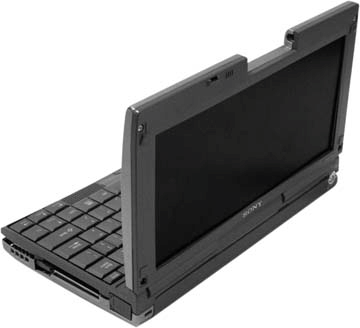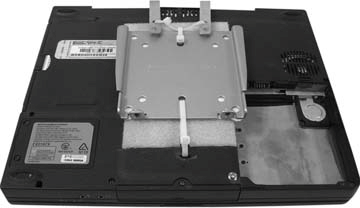Hack31.Turn Your Laptop into a Fold-Down or Dashboard Screen
Hack 31. Turn Your Laptop into a Fold-Down or Dashboard Screen
You may already have a nice LCD screen for your car, in the form of an old laptop. We haven't yet exhausted all the ways to get a flat screen into your car. A laptop, old or new, can be an excellent solution for an in-car installation. Laptops have beautiful, large LCD screens, but they do have a few drawbacks. For one thing, they almost always have thin, fragile, proprietary connectors for which you can't easily make extension wires. Second, except for a few specialized models, laptop screens usually have a big keyboard and computer sticking out of them. Finally, if a laptop screen is mounted on a ceiling, it will be upside-down. But don't worry, there are solutions to all of these problems. 3.10.1. In-Dash or In-Seat MonitorIn the late 1990s, when computers weren't even powerful enough to play DVDs, Sony made a thin laptop called the Clié that had a strange screen resolution: 1024 x 480. It was about the size of a VHS cassette tape. My friend used one as a portable MP3 player in his Mazda RX7 years before there were any MP3 players on the market. At the time, I was upgrading the stereo system for my 1950 Nash Ambassador, which has a radio that hides behind a roll-down cover. The size of the radio slot is hugeas you'd guess, about the size of a Sony Clié screen. The big problem was that the Sony Clié would not bend 270 degrees backwards, as I wanted it to, without threatening to break. So I did what any hacker would doI took it apart to see if I could encourage it to rotate. And indeed I could (see Figure 3-12). In practice, while you will find that it's difficult to extend the length of the cord between a laptop and its monitor, reversing the position of the monitor 180 degrees will work. To do this, you have to do a lot of disassembly. (Although manufacturers usually don't publish the take-apart manuals for their laptops except for authorized service, you may be able to find this information by searching the Web for your make of laptop, or by contacting the manufacturer.) First, take off the outer plastic of the LCD bezel (the thin plastic frame that surrounds the screen). Then, remove the casing from the top of the laptop around the LCD hinges. Depending on your model, you may have to remove the entire laptop case. You will now have several ribbon cables and the power cord exposed. There should be two to four screws mounting the hinges to the body of the laptop, and once you remove these the LCD screen should be free from the body of the laptop. You can turn the LCD screen 180 degrees at this point, and in many cases, you will see how you can screw the hinges on in this reversed orientation. You can usually carefully flip over the thin plastic ribbon cable that goes to the LCD so that it still fits neatly into the thin path through the plastic or metal hinge covers. You may find that there is some asymmetry in the design, and while the hinges will fit, the cover will remain about 15 degrees open instead of closing completely. This may affect your ability to mount it flat (for instance, in a dashboard or flush in a seat back). However, if you don't reattach the hinges, but simply securely Velcro your screen to the bottom of the laptop, it will pack flat, providing you with a compact screen and computer combination, ready for flush mounting in your dashboard or the back of the front driver's or passenger's seat. Figure 3-12. A reversed laptop screen 3.10.2. Fold-Down LaptopPerhaps you have a working laptop that you want to suspend from your car's ceiling, rather than embedding it in the dash or a seat back. A laptop already has a tidy closed position, and if it's a newer laptop it will have an optical drive for you to play DVDs. The first step is to make sure that your laptop screen can be inverted. Portrait Displays, Inc. (http://www.portrait.com) makes software called Pivot Pro that can invert your screen. The software is inexpensive, and you can download a free trial to make sure it works before embarking on a large upside-down laptop installation. If you can invert the screen, the next step is to figure out where to mount the laptop on your ceiling. To mount a laptop, you want to create a very secure mounting bracket. Since you probably want the lid to close flush, you can't have anything too thick going around the laptop to hold it up. Also, since you want to be able to remove the laptop without taking it apart, you need a two-piece mounting solution: something that connects to the laptop, and another bit that connects to the ceiling. The basic approach is:
How you do this depends on how heavy your laptop is, how clean a fit you want, and how good you are at fabrication. Since a laptop does not come with a convenient mounting bracket and is generally heavier than a fold-down screen (it also includes a computer!), you have to make sure you mount it securely enough to support its weight. In my installation, I used OmniMount's QM-100F, a two-piece flat wall-mounting bracket for LCD screens. Figure 3-13 shows how I mounted one of the brackets to the bottom of my laptop, using zip ties, metal L-brackets, and some screws. This step varies from laptop to laptop, and is left as an exercise for the reader. Figure 3-13. A ceiling-mount laptop bracket Once you have chosen your laptop mounting solution, you need to drill the holes to attach the ceiling bracket, and then mount it. You'll also need to figure out what wires you need to route, and run them above the headliner [Hack #29]. Once you get all the wires to the edge of the vehicle, run them down one of the door pillars. Depending on how many wires you want to run to elsewhere in the vehicle, you may need to get extender cables for USB, VGA, and even the power cord. (If you use a wireless mouse and keyboard, you can run fewer wires.) Note that running the VGA cable is usefulyou can use it to drive another screen elsewhere in your vehicle, such as a dash-mounted VGA touchscreen [Hack #26]. You need to get a 12V car power adapter for your laptop, and you need a wire that runs from your laptop through the ceiling and down to the floor, where it then meets the power. You don't have to buy a power cord extender; you can extend the power cord with any wire of similar thickness by splicing it, soldering it, and heat shrinking it [Hack #4], as long as you preserve the polarity by making sure the center wire and outer wire stay connected correctly. For a clean look, you may want to cover the exposed portions of the laptop frame with plastic, vinyl, leather, or a similar covering that matches your interior. You should be able to get plastic covers for the screws you use as well. For a completely clean installation, you can have a fabricator make a fiberglass shell that covers the front and back of the laptop, and even paint your laptop case cover to match your car's interior. But most laptops close up pretty flat and tidy, and you only need to cover the bundle of wires that comes out of the back of the laptop. |